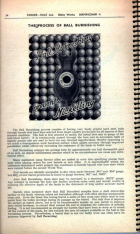To all.... I will come right out and say it.... slugging barrels I don't agree with for multiple reasons. Argue with us all you want.
Customer feels his gun wasn't shooting good enough. So he makes his own steel bushing to slug the bore and threads it on to a cleaning rod and pushes it down the bore. He feels there are tight spots in it. I'll guarantee the barrels bore/lands are all scored and the barrel is junk! No warranty!!!!!!
No information on how he's cleaning it, caliber, how many rounds on it etc....I told him flat out.... not going to warranty the barrel. Not to mention no information given as to the actual diameter to the .xxxx" place the bushing was made to and what equipment was used to measure the bushing.
We had a gun manufacturer without even talking to us.... decided they were going to check the bore size of the barrels.... yes they pushed gauge pins down the bores of not one... not two but around a couple of hundred of our barrels.... every barrel the lands were scored and damaged!
Not to mention any lint or debris in the bore or any type of fouling... it's just going to amplify making something to go sour.
Don't even argue, lead slugging isn't any better or won't cause any issues. It will not give you accurate measurements.
Even Mark has gone off on guys saying they slugged a bore with a lead slug and tried to measure the grooves.
There are maybe two guys.... that I/we know that will tell you they have slugged/checked bores and they are honest in saying they can get close to the size but even what they come up with is subjective.
Later, Frank
Bartlein Barrels
Customer feels his gun wasn't shooting good enough. So he makes his own steel bushing to slug the bore and threads it on to a cleaning rod and pushes it down the bore. He feels there are tight spots in it. I'll guarantee the barrels bore/lands are all scored and the barrel is junk! No warranty!!!!!!
No information on how he's cleaning it, caliber, how many rounds on it etc....I told him flat out.... not going to warranty the barrel. Not to mention no information given as to the actual diameter to the .xxxx" place the bushing was made to and what equipment was used to measure the bushing.
We had a gun manufacturer without even talking to us.... decided they were going to check the bore size of the barrels.... yes they pushed gauge pins down the bores of not one... not two but around a couple of hundred of our barrels.... every barrel the lands were scored and damaged!
Not to mention any lint or debris in the bore or any type of fouling... it's just going to amplify making something to go sour.
Don't even argue, lead slugging isn't any better or won't cause any issues. It will not give you accurate measurements.
Even Mark has gone off on guys saying they slugged a bore with a lead slug and tried to measure the grooves.
There are maybe two guys.... that I/we know that will tell you they have slugged/checked bores and they are honest in saying they can get close to the size but even what they come up with is subjective.
Later, Frank
Bartlein Barrels













